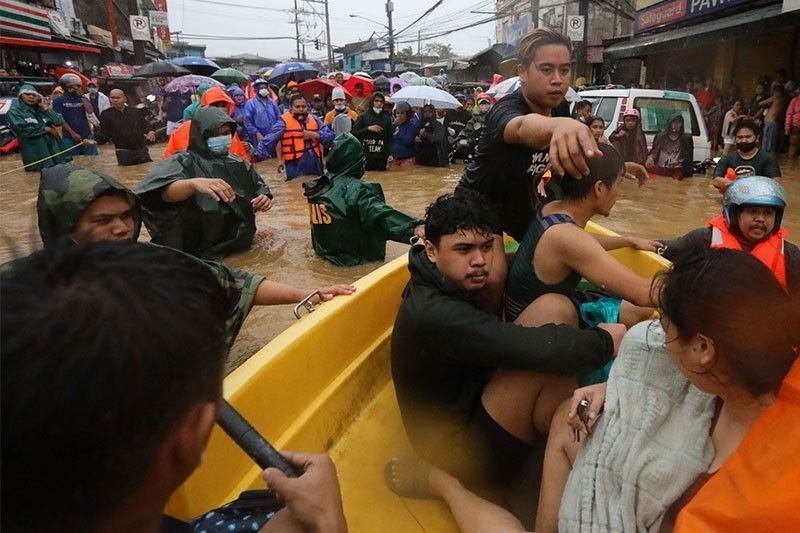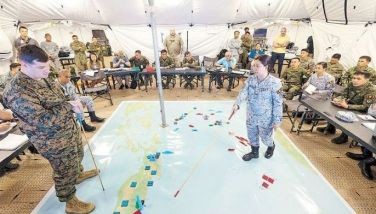Gov’t urged to prevent COVID-19 ‘superspreading’ at evacuation centers

MANILA, Philippines — As the country grapples with the wreckage caused by three typhoons in as many weeks, senators are urging government agencies to ensure that the evacuation of hundreds of thousands of Filipinos will not lead to a dramatic rise in coronavirus infections.
"This is worse than Typhoon Ondoy. Not only did this trigger one of the worst flooding in history, it also happened in the middle of a pandemic. In whatever way the government can make this time easier, we must,” Sen. Risa Hontiveros said, urging the health and interior departments to provide free face masks and alcohol at shelters.
"If we think the situation is bad now, it will be even worse if our evacuation centers turn into COVID superspreaders. Many of the victims have already lost everything, then they'll get sick? Let's help them avoid COVID-19," she added in Filipino.
Latest data from the Department of the Interior and Local Government shows that 345,119 individuals — or 102,806 families — are currently in evacuation centers. Secretary Eduardo Año on Friday morning cautioned that these figures do not represent the total number of those displaced, however, as some may have chosen to take shelter with their relatives amid the typhoon.
Hontiveros further called on the Department of Health to deploy doctors to evacuation centers to check for symptoms and other health concerns, "especially for the senior citizens, children and immunocompromised," and to ensure quick isolation and referral to hospitals if needed.
Protection for children affected by typhoons sought
Meanwhile, Sen. Win Gatchalian called on the social welfare department to ensure that relief efforts address the needs of the children affected by the typhoons, including their safety from COVID-19.
Citing the United Nations Office for the Coordination of Humanitarian Affairs, Gatchalian said an estimated 724,000 children were affected in areas hit by Super Typhoon Rolly alone.
"The United Nations Children’s Fund (UNICEF) also warned that the most affected children, including their families, are at increased risk of COVID-19 infection and other diseases because of crowding in evacuation centers," a statement released by Gatchalian reads.
He further emphasized the importance of implementing the Comprehensive Emergency Program for Children (CEPC) which he said "should serve as the basis for handling disasters and other emergency situations to protect and support the immediate recovery of children, as well as pregnant and lactating mothers." The CEPC was created under Republic Act No. 10821 or the Children’s Emergency Relief and Protection Act.
Local government units, Gatchalian noted, "are also mandated to integrate the CEPC in their Local Disaster Risk Reduction and Management (LDRRM) plans and budget."
Along with Hontiveros, Gatchalian urged that public health supplies such as face masks, alcohol and sanitizers should be distributed to children and their families, as the immediate delivery of basic necessities is ensured by the CEPC under law.
"Part of the components of the CEPC is the establishment of child-friendly spaces in areas under a state of calamity. The program also mandates the [DOH] to coordinate with the DSWD, [local government units], and civil society organizations (CSOs) to provide the health, medical, and nutritional needs of affected children, including psychosocial interventions," he said.
He also stressed the importance of having a permanent evacuation center in every city and municipality to avoid the use of classrooms as temporary shelters and delays in the resumption of classes. The onslaught of typhoons have necessitated the use of public school classrooms as evacuation centers, many of which went unused this school year as the pandemic forced a shift to distance learning.
The need to prepare for overlapping calamities
In October, Advocacy group Agap Banta warned that even though the country has invested significantly in strengthening the preparedness and response capabilities in national, local and community levels, the overlapping of another disaster with the pandemic response and recovery would be “overwhelming.”
“While health impacts of disasters have been well-recognized, anticipated and responded to during typhoons, preparedness and health emergency response plans have not been simulated and tested nationwide. Dealing with a combined emergency remains a big challenge,” Agap Banta told Philstar.com in an email exchange.
The group said there was a need to re-layout existing evacuation centers to a camp management set-up to prevent transmission of the virus.
They explained that this can set-up can be achieved through the implementation of the following:
- housing only one family per tent
- setting up a triage area in the entrance of evacuation centers to assess health conditions of evacuees
- increase access to water, sanitation and hygiene facilities
- providing clear markings for physical distancing at the assigned food and non-food items distribution area
- arranging contactless distribution of family food packs and hygiene kit, if possible
READ: La Niña amid pandemic: What local governments, communities can do to prepare
— Bella Perez-Rubio with a report from Gaea Katreena Cabico
- Latest
- Trending





























